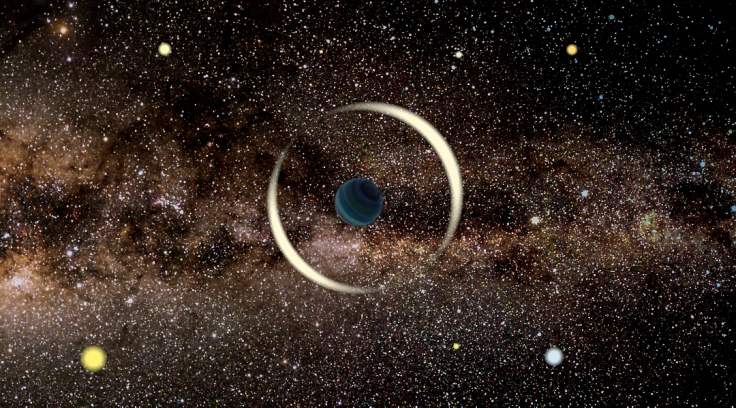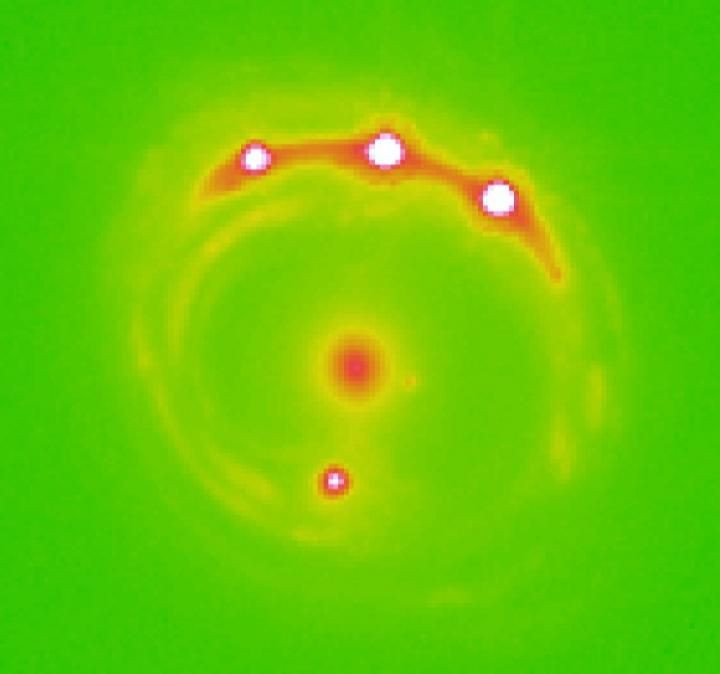Farthest-Known Exoplanets Discovered Outside Milky Way, Thanks To Gravitational Lensing

Large objects in space tend to distort and magnify the light coming from objects behind them, allowing scientists to see things which would otherwise not be observable at all. This phenomenon is called gravitational lensing and using it, astrophysicists from University of Oklahoma (OU) have discovered, for the first time, planets outside the Milky Way.
Exoplanets — the name given to all planets outside our solar system — were first discovered in 1992, and thousands have been discovered since. But all those known exoplanets are inside our home galaxy. But Xinyu Dai and Eduardo Guerras from OU published a paper Friday in which they identify the presence of about 2,000 planetary mass bodies in a galaxy located 3.8 billion light-years away.
The galaxy they studied is a quasar, RXJ 1131-1231, which is thought to be a phase in the evolution of some galaxies. The supermassive black hole at its center wields an enormous amount of gravity, which causes gravitational lensing. The planets it revealed range in mass from the moon to Jupiter, and are likely unbound — they don’t orbit stars.
“We are very excited about this discovery. This is the first time anyone has discovered planets outside our galaxy. These small planets are the best candidate for the signature we observed in this study using the microlensing technique. We analyzed the high frequency of the signature by modeling the data to determine the mass,” Dai explained in a statement.

The raw data for the observations came from NASA’s Chandra X-ray Observatory, a space telescope operated by the Smithsonian Astrophysical Observatory. The microlensing models were made at the university. And the researchers stressed using a technique like gravitational lensing was the only way to make such a discovery.
“This is an example of how powerful the techniques of analysis of extragalactic microlensing can be. This galaxy is located 3.8 billion light years away, and there is not the slightest chance of observing these planets directly, not even with the best telescope one can imagine in a science fiction scenario. However, we are able to study them, unveil their presence and even have an idea of their masses. This is very cool science,” Guerras said in the statement.
The paper, titled “Probing Planets in Extragalactic Galaxies Using Quasar Microlensing,” appeared in the Astrophysical Journal Letters.
Another paper, also published Friday by an international team of researchers, used gravitational lensing to set a new magnification record of sorts. With a massive galaxy cluster in the foreground, the scientists identified a distant galaxy, located about 22 billion light-years away, because it had been magnified 30 times.
“The very high magnification of this image provides us with a rare opportunity to investigate the stellar populations of this distant object and, ultimately, to reconstruct its undistorted shape and properties,” study coauthor Johan Richard from University of Lyon, France, said in a statement.

Similar magnification has been observed before, but why this one stands out is due to the nature of the background galaxy which was discovered. It is a quiescent galaxy, which means it doesn’t produce new stars and is therefore extremely faint. Considered the last of galactic evolution, quiescent galaxies are common even in the local universe.
“As we look at more distant galaxies, we are also looking back in time, so we are seeing objects that are younger and should not yet have used up their gas supply. Understanding why this galaxy has already stopped forming stars may give us critical clues about the processes that govern how galaxies evolve,” Mikkel Stockmann, another coauthor, from the University of Copenhagen, said in the statement.
The data for this study was taken from observations made by the Hubble Space Telescope.
Titled “Thirty-fold: Extreme Gravitational Lensing of a Quiescent Galaxy at z = 1.6,” this study also appeared in the Astrophysical Journal Letters. The lead author was Harald Ebeling from the University of Hawaii.
Gravitational lensing is a very useful tool for studying distant objects in space, but it can also create problems for astronomers who study the Cosmic Microwave Background — the omnipresent radiation from soon after the Big Bang, one of the few things which allow us to study the universe in its infancy. The strong gravitational effects of various large objects in space complicates the observation of the CMB, and researchers have previously proposed a “delensing” method to overcome this encumbrance.
© Copyright IBTimes 2024. All rights reserved.





















